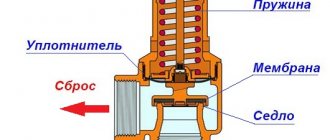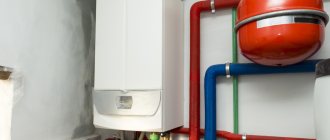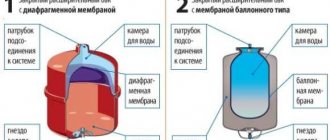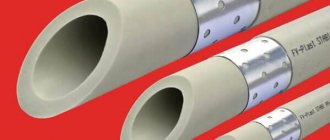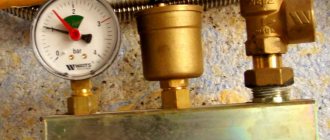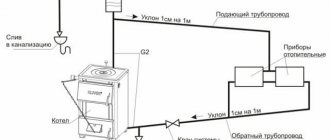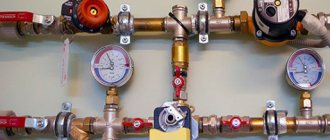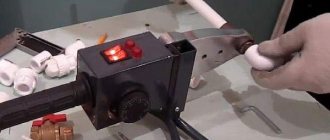Regulatory framework regulating operating pressure in the heating system
Absolutely all multi-storey buildings in the country, regardless of their commissioning, have a forced supply of coolant. Thanks to the operating pressure of the heating system, hot water gets into the pipes and radiators of each apartment, which ensures high heating performance. The action helps to avoid unnecessary heat loss by delivering water to all apartments at the same temperature, which is obtained when heating the boiler room.
The operability of the structure is specified by standard number 12.1.00588, 565012015, SNiP 41-01-2003, SP 60.13330.2012, SP 60.13330.2016, Ch. VI Appendix 1 of Government Decree No. 354. Documents indicate that at normal pressure, room temperature will be between 20 and 22°C, with the existing humidity not exceeding 45%.
The different number of storeys of a building is determined by different pressure indicators:
- 5-floor house – 2-4.0 atmospheres;
- 10 – 4-7,0;
- over 10 floors – 8.0-12.0 atm.
The task of the system is to uniformly heat apartments located on different tiers. A factor is considered acceptable when the difference between the working pressure on the first floor of a high-rise building and the last is no more than 10%.
In summer, the system sets minimum levels. The pressure is calculated as follows:
0.1(H×3 + 5 + 3),
where H is equal to the number of floors.
In addition to the height of the building, the coefficient depends on the temperature of the carrier entering the house.
The law establishes minimum functions:
- when heated to 130°C, the pressure is 1.70-1.90 atm;
- 140° — 2,60-2,70;
- 150°C – 3.80 atmospheres.
Systematic checking of the necessary indicators is carried out during the heating seasons and between them. In winter, control occurs using pressure gauges that are installed in the house on the supply and return lines.
The input must comply with legal standards, and the difference at the first node and at the output must fluctuate between 0.10-0.20 units. If the latter indicator is not detected, this indicates a lack of movement of hot media on the upper floors. An increase in the difference indicates existing heat element leaks.
In summer, testing of the system is carried out by hydraulically testing the batteries using cold water supplied by a pump. If the value drops by more than 0.070 mPa in the next half hour, depressurization of the heating configuration is detected. A decrease in pressure within 90-120 minutes is considered acceptable. by 0.020 mPa.
Watch the video: “Why the pressure in the heating system drops and what needs to be done.”
Pressure in an open heating system
Unlike a closed thermal circuit, a properly constructed open heating system does not require balancing over years of operation - it is self-regulating. Boiler operation and static pressure ensure constant circulation of water in the system.
The density of the heated water following the supply riser is lower than the density of the cooled coolant. Hot water tends to occupy the highest possible point of the circuit, and cooled water tends to be at its very bottom.
The pressure required for water circulation is achieved by the pressure in the supply riser or by a booster pump (+)
The pressure developed by the water column in the supply riser promotes the circulation of the coolant and compensates for the resistance present in the circuit pipeline. It is caused by the friction of water on the inner surface of the pipes, as well as local resistance (turns and branches of the pipeline, boiler, fittings).
By the way, pipes of increased diameter are used to assemble an open heating system precisely to reduce friction.
To understand how to increase pressure in an open heating system, you must first understand the principle of achieving circulation pressure in the thermal circuit.
Its formula:
Rts = h • (ro-rg),
Where:
- Рc – circulation pressure;
- h – vertical distance between the centers of the boiler and the lower heating radiator;
- рг – density of the heated coolant;
- ro – density of the cooled coolant.
The static pressure will be higher if the distance between the central axes of the boiler and the battery closest to it is as significant as possible. Accordingly, the intensity of coolant circulation will be higher.
To achieve the maximum possible pressure in the heating circuit, it is necessary to lower the boiler as low as possible - into the basement.
The closer the radiator is to the boiler on the supply circuit, the better it warms up. Regulators allow you to distribute heat between all radiators of the heating system
The second reason for the drop in pressure in an open heating system is related to its self-regulation. When the heating temperature of the coolant changes, the intensity of its flow changes. By increasing the heating of water for the heating circuit on cold winter days, owners sharply reduce its density.
However, when passing through heating radiators, water gives off heat to the room atmosphere, and its density increases. And according to the formula presented above, a high difference in the densities of hot and chilled water helps to increase the circulation pressure.
The more the coolant is heated and the colder it is in the rooms of the house, the higher the pressure in the system will be. However, after the atmosphere of the premises warms up and the heat transfer from the radiators decreases, the pressure in the open system will drop - the difference between the supply and return water temperatures will decrease.
Balancing a double-circuit open heating system
Gravity heating systems are made with one or more circuits. In this case, the horizontal length of each looped pipeline should not exceed 30 m.
But to achieve optimal pressure and pressure in an open system with natural coolant movement, it is better to make the pipelines even shorter - less than 25 m. Then it will be easier for water to deal with hydraulic resistance. In a circuit with several rings, in addition to limiting the length, the condition for heating radiators must be observed - the number of sections in all rings must be approximately equal.
Lack of pressure in an open double-circuit thermal system occurs due to design errors or contamination of the pipeline (+)
Balancing of the horizontal rings included in the vertical circuit is required at the design stage of the heating system. If the hydraulic resistance of any ring turns out to be higher than that of the others, the static pressure in it will not be enough and the pressure will practically stop.
To maintain the required pressure in a double-circuit heating system, it is necessary to reduce the cross-section of the pipes approaching the radiators. You can also install valves in front of the radiators that perform thermoregulation (manual or automatic).
You can balance an open-type dual-circuit system:
- Manually. We start the heating system, then measure the temperature of the atmosphere of each heated room. Where it is higher, we screw the valve, where it is lower, we unscrew it. To adjust the thermal balance, you will have to perform temperature measurements and adjust the valves several times;
- Using thermostatic valves. Balancing occurs almost independently; you just need to set the desired temperature in each room on the valve handles. Each such device will control the supply of coolant to the radiator itself, increasing or decreasing the supply of coolant.
It is especially important that the value of the total hydraulic resistance of the heating system (all rings in the circuits) does not exceed the value of the circulation pressure. Otherwise, warming up the coolant and attempting to balance the system will not improve circulation.
Circulation pump for open heating system
It happens that measures to balance the heating circuit of a gravity system have no effect. Not all causes of low pressure can be solved by adjustment - choosing the wrong pipe diameter cannot be corrected without a complete reconstruction of the circuit.
Then, in order to increase the pressure and improve the movement of water without significant modifications to the heating, a circulation pump or booster pumping device is installed in the system. The only thing that its installation will require is moving the expansion tank or replacing it with a membrane expansion tank (closed tank).
In case of a serious drop in pressure, not a circulation pump, but a more powerful booster pump is needed. However, booster pumps are not suitable for open heating systems, because develop significant dynamic pressure
The energy consumption of circulation pumps does not exceed 100 W. Therefore, there is no need to fear that it will push the coolant out of the circuit.
The volume of water in the heating system is more or less constant, provided that the filling of the open circuit is controlled. Therefore, no matter how much water the circulation pump pushes along the circuit in front of it, the same amount will flow into it from the return pipe.
By bringing the pressure in the thermal system to the required level, the pump will make it possible to lengthen it, reduce the diameter of the pipeline and achieve circuit balance with high hydraulic resistance.
Pressure function in a heating system
The operating pressure in the heating system serves to maintain high efficiency of the artificial heating circuit. The condition ensures the delivery of hot water from the boiler room to the structure of the residential building until the radiators take on a certain amount of thermal energy.
The pressure of heating networks has several types:
- static - determining the pressure on the internal walls of pipelines depending on the number of floors of the building, and the liquid remains motionless;
- dynamic - formed due to the launch of the centrifugal pump and the supplied medium;
- worker, is represented by the sum of the first two pressures, ensuring the continuous functioning of all elements of the heating system.
The latter includes a circulation pump, a heat generator, an expansion tank and pipes.
Standard pressure in central heating and methods for measuring it
What pressure in batteries and pipes is considered standard? This indicator is determined by the relevant “Building Codes and Regulations”. According to the latter, pressure is determined depending on the following factors:
- heating system power;
- area of the house;
- pipeline diameter;
- pipeline type;
- distance from the boiler room.
As an example, we give a calculation for a multi-story building nine floors high. In this case, the standard operating pressure in the system is from 5 to 7 atmospheres. But if the height of the building exceeds nine floors, then this indicator is already from 7 to 10 atmospheres. Moreover, with a lower supply, a difference in pressure on the first and last floors is inevitable. According to the standards, it should not exceed ten percent. This means that if on the first floors the pressure is ten atmospheres, then on the upper floors it should be at least nine.
If we talk about test pressure standards, it is believed that the safety factor can be checked if it is 15-20 percent higher than the working pressure. This is due to the fact that with possible water hammer, the load on the system elements increases significantly, although not for a long time. Therefore, the safety margin of radiators and pipes must withstand such a load.
How to measure pressure in pipelines? The device with which this is done is called a pressure gauge. They are usually always installed in the basement of a building to control the pressure entering the system. But you can also install a pressure gauge in your own apartment to constantly be aware of the pressure in pipes and radiators. As a rule, this device crashes into the heating battery at the entrance.
Pressure norm
Compared to the heating main, where the water pressure is 12 atm, the pressure in the heating system of the building is slightly less - about 10 units. Poorly adjusted configuration, losses are reduced to 5.5 atmospheres.
Between heating periods, an index is maintained in the pipes that exceeds the static index. This protects the wiring from oxygen and corrosion. The minimum value of the given condition depends on the height of the residential building with a margin of 3-5 meters.
Differences between static and dynamic pressure
The artificial heating pressure of MKD has several main types.
These are:
- Static pressure. Indicates the force with which a column of water presses on the inner walls of pipes and radiators, depending on their height. In calculations, the surface pressure of the liquid is taken as zero (0).
- The dynamic indicator arises due to the movement of hot media inside pipelines and batteries.
- The operating state consists of the two previous indicators, which ensure trouble-free operation of all elements of the heating structure.
The last characteristic has its own conditions, which are expressed by coefficients:
- low-rise buildings with a closed circulation type - 0.20-0.40 mPA;
- one-story buildings with natural circulation of hot media and an open model - 0.10 mPa for every 10.0 m of water column;
- high-rise buildings - approximately 1.0 mPa.
The role of static pressure is expressed by the pressure of the liquid in a closed heating circuit on the apartment’s radiators and its wiring, depending on the number of floors. If we take this formula as a basis, then for every 10 meters of height there is one additional atmosphere.
Where does the heat in batteries come from?
The additional pressure is dynamic. The latter is caused by the pressure of water on pipelines and batteries during the movement of hot media. When installing a closed circuit for artificial heating of a building with a centrifugal pump, it is necessary to take into account the combined static and dynamic pressure, a feature of the equipment. For example, a cast iron radiator is designed for an operating use of 0.6 mPa.
Difference between supply and return
The performance of any heating communication is expressed by a stable and defined pressure difference. The pressure difference in the heating system between supply and return should not be less than 0.20 MPa. If such a decrease exists, this is explained by the passage of hot water through the radiators without heating them to the required degree.
If the indicator is exceeded, it indicates airing of the heating circuit. Sudden changes in pressure negatively affect the artificial heating equipment of the apartment, even to the point of its breakdown.
Peak value
The closed-form heating scheme is determined by the passage of liquid through a closed cycle, without communication with the external atmospheric environment. The tightness of the first is ensured by an equipped membrane expansion tank. It can be installed in any part of the circuit, as opposed to a conventional tank. Most wall-mounted heating boiler devices are equipped with membrane expanders.
Circulating through a closed space, the liquid creates a certain pressure. For private houses, pressure up to 2 atm is considered normal; for taller cottages it is stronger. The performance limit is calculated based on the weakest element of the circuit. This is usually the heating boiler.
The most resistant to loads can withstand no more than 3 atm. However, in small houses, budget models are installed, where the figure is halved. High-rise buildings allow peak performance of up to 20 units or more. But old batteries and pipes, not designed for such pressure, are destroyed under the influence of water hammer. Therefore, it is customary to equip multi-story buildings with pipelines and radiators that can withstand pressures of up to hundreds of atmospheres.
Types of pressure in pipes and radiators
There are different types of pressure - depending on the processes that occur in the heating system:
- static pressure determines the physical effect of the coolant, which is at rest, directly on the heating system. In this case, the static pressure indicators will directly depend on the height of the heated house, that is, on the height of the water column;
- the operating pressure is obtained by adding dynamic and static pressure, with the former occurring already when the pump is running. This parameter must be maintained throughout the heating season;
- the test pressure significantly exceeds the operating and static pressure, since it is created forcibly when the system is started. Such tests help to identify weak and vulnerable areas and identify all cracks and leaks in the pipeline.
Let's consider the pressure in the pipeline and radiators depending on the heating schemes used - single-pipe and double-pipe.
Single-pipe
The peculiarity of this scheme is that, using a circulation pump, the coolant is driven through only one pipe, passing through heating devices on all floors. The biggest disadvantage of this scheme is that if one of the radiators breaks down or there is air pollution, the heating system of the entire house may fail.
We recommend: How to repair bimetallic heating radiators with your own hands?
In order to avoid this, it is necessary to install shut-off valves at the places where the battery is connected to the pipeline. In addition, a bypass is required between the supply and outlet pipes directly in front of the heating device. Only in this way, if one of the radiators breaks down, can you easily repair or replace the device by shutting off the coolant supply.
Horizontal single-pipe heating system
Two-pipe
Most often in apartment buildings, a two-pipe heating scheme is now used. The main difference from the single-pipe scheme here is that there is both a pipe for supplying coolant and for its return. So, each radiator is connected to two pipes at once - supply and return. Therefore, it is possible to supply coolant at the same temperature on all floors, and return the cooling water through a separate line.
With any radiator connection scheme, pressure in the system is necessary, first of all, to provide it with coolant and maintain the same comfortable temperature in the apartments for everyone. It goes without saying that the more floors in the building, the greater the pressure required. Accordingly, pipes and radiators are selected for this indicator.
It is extremely important that pressure readings are always within acceptable limits for the system. Otherwise, exceeding the operating pressure can lead not only to the breakdown of individual elements, but also to the failure of the heating system of the entire house. But too low a pressure can cause certain difficulties: the coolant either does not reach the upper floors, or the latter boils (cavitation).
Factors of unstable pressure
The indicators of the stable onslaught of high-rise buildings depend on both the number of storeys and other conditions.
Deviation from legally established standards occurs for the following reasons:
- clogging of the internal walls of pipelines and radiators with debris, scale, and lime deposits leads to the fact that the pressure in the heating system in an apartment building becomes unstable;
- unintended absence of electric current in a boiler room equipped with centrifugal pumps, or their failure, which leads to a decrease in pressure;
- depressurization of the circuit and subsequent leakage of coolant;
- low room temperature of the elevator unit can affect the increase in pressure;
- unauthorized installation by residents of additional sections of heating devices, heat exchange equipment of high thermal output, pipes of non-standardized diameter, bringing them to the balcony;
- air locks formed due to untimely checking of batteries before the start of the season;
- inappropriate quality of the coolant coming from the boiler room leads to pressure instability;
- water hammer - an instantaneous unforeseen increase in pressure, for which radiator models of the last century, intended for low-pressure boiler houses, were not designed.
When replacing old batteries with new ones, you need to pay attention to the safety margin of the latter; they must have at least 13 atmospheres.
During preparatory work before the start of winter or after repairs, the artificial heating circuit undergoes pressure testing. At the same time, the pressure in the heating system of a multi-story building increases by almost one and a half times. This period is characterized by frequent changes in the pressure of the hot medium.
What is the optimal pressure in the heating system of a multi-storey building?
The efficient operation of the heating system in an apartment building depends not only on temperature, but also on coolant pressure. Deviation from the standard value, either upward or downward, is fraught with serious problems: from insufficient heating of the apartment to destruction of elements of the heating system.
The productivity of centralized heating depends on the magnitude of the working pressure - a constant and stable pressure should “deliver” the coolant to each radiator of an apartment building with almost the same temperature as at the exit from the boiler room.
Diagram of the heating system of a multi-storey building
Working pressure in the heating system of a multi-storey building - norms
The actual coolant pressure in a central heating system is the sum of static and dynamic pressures. The first parameter depends on the height of the building; it determines the force that is created by the liquid column above the measurement point. The second indicator is more intense, as it characterizes the force with which the coolant acts on the elements of the heating system when moving.
When calculating the heating circuit and selecting radiators, operating and test pressures are taken into account.
Working pressure is the indicator with which the system operates in trouble-free mode throughout the heating season.
Test pressure is created forcibly - using special pumps in order to identify and eliminate leaks and hidden defects in radiators, pipelines and their connections.
What pressure in the heating system of a multi-storey building can be considered normal?
Acceptable values are specified in regulatory documents (SNiP), and depend on the number of floors and area of the building, its distance from the heating network or boiler room, the type and diameter of pipelines, as well as the power of the entire heating system. The coolant pressure must be sufficient to reach the outermost radiator without significant heat loss, regardless of the length of the supply pipeline.
Pressure for heating an apartment building
Now in numbers:
- For multi-storey buildings (up to 9 floors) the operating pressure is 5-7 atm.
- For higher-rise buildings this figure does not exceed 7-10 atm.
- The test should be 15-20% higher.
The difference in readings on the first and last floors can be up to 10% of the nominal value - this is the permissible deviation for high-rise buildings.
The coolant pressure in the supply heating mains can reach 12 atm - this indicator also determines what water pressure in a multi-story building will be from a hot tap and whether it will be enough to “raise” the pressure to the top floor.
The main reasons for the increase and decrease in coolant pressure
The actual value does not always correspond to the standard values - the working pressure of the coolant in the heating circuit is influenced by many factors:
- Diameter of pipelines. Even at the design stage of the heating system, the cross-section of the pipes used is calculated so that the water pressure in the risers of apartment buildings complies with the standards. Unauthorized replacement by some residents of pipelines in an apartment with a larger (or smaller) diameter can lead to a decrease (or increase) in pressure in individual rooms. In the first case, for remote apartments there will not be enough “power” of the coolant and there will be insufficient heating, and in the second, leaks of heating elements that are not designed for increased pressure are possible.
- Power and equipment wear. Pressure in a multi-storey building is created due to the equipment of heating networks, the condition of which worsens every year even during scheduled repairs. Wear of main components, damaged pipelines, faulty shut-off valves and low quality coolant lead to a decrease in pressure in the heating circuit.
- Air jams. The formation of air jams occurs as a result of repair work and subsequent filling of the system if the water pressure in the water supply of an apartment building was below the required value. In “aired” areas, the circulation of the coolant is reduced or absent, so before the start of the heating season the air must be “bleeded off”.
- Location of heating devices. The actual operating pressure depends on the location of individual radiators - in corner rooms the coolant pressure is always lower.
- Wear of batteries and scale on pipes. The deposition of foreign impurities (due to the low quality of the coolant) on the pipes and walls of heating devices, their wear and tear lead to a decrease in the flow diameter by almost half and the performance of the system in individual apartments decreases. To eliminate “problematic” blockages, the risers are flushed, and it is better to replace old batteries.
Hydropneumatic testing of a heating system in a high-rise building
The essence of hydropneumatic testing of the system
The purpose of testing a heating system with excess pressure is to detect leaks and hidden defects in radiators, pipelines and their connections, as well as to prevent accidents due to possible water hammer. The inspection procedure is carried out after preliminary flushing of the main pipeline in order to remove scale and dirt deposits from the internal walls.
Hydropneumatic tests are carried out after preparatory work in two stages:
- First, the system is filled with cold water from a centralized main. The water pressure in an apartment building does not exceed 6 atm, so it cannot be called “excessive” for checking the system. Increase the value using special pumps to the required value (+ 15-20% of the operating value) and hold for 30 minutes - the pressure gauge readings should not change. After another 120 minutes, pressure loss should not exceed 0.2 atm.
- Immediately before the start of the heating season, the system is tested according to the same principle, only with hot water. If the coolant pressure remains within the normal range, the system has passed the leak test and is considered pressurized.
Conclusion
Residents of an apartment building do not have the ability to independently control and change the coolant pressure, although the temperature comfort in each apartment directly depends on this critical indicator.
If service providers and heat supply organizations comply with established standards and requirements, they guarantee not only high performance of heating equipment and a reduction in heat loss, but also its safe operation.
climanova.ru
Factors influencing blood pressure
Measuring instruments in the elevator unit room note any disruption in the supply or drainage of water from the building.
Increased pressure in the heating radiators of an apartment building can be created by the following factors:
- the temperature of the hot resource is too high compared to the established norm;
- the diameter of the pipe distribution was reduced due to unauthorized reconstruction by residents of the apartment heating scheme;
- formation of air jams in the end radiators of floors;
- the use of centrifugal pumps of greater power than provided for in the plan;
- part of the system is not working or is blocked.
A decrease in agent pressure also indicates a problem with the heating circuit.
When the pressure drops, you need to pay attention to the following possible aspects:
- emergency situations when supply pipelines rupture;
- malfunction or unsatisfactory operation of the circulation pump;
- failure of the safety unit;
- rupture of the expansion tank resonator.
Types of heat supply systems.
Silting or clogging of the filter in front of the elevator unit also contributes to a drop in pressure.
A leak
The leakage of water from the heating circuit is the most common factor in reducing the pressure of the coolant. Most often, ruptures occur at the junction of pipes with the boiler and heating equipment.
A break is also possible in other arbitrary places if the owner of the apartment or house did not conduct a visual inspection before the start of the season, or installed defective elements.
A hot agent leak can occur in several ways:
- Through a rupture in the diffuser of the expansion tank. Such an accident cannot be visually determined due to the presence of water inside the container. To check, you need to press your finger on the valve that pumps air into the tank. When water leaks out of the spool, we can talk about a membrane crack.
- When the resource boils in the heat exchanger, through the relief valve.
- Microcracks, corroded areas of measuring instruments, and loose connections can also contribute to a drop in pressure and leakage of water.
The surest way to determine a possible leak is to turn off the circulation pump. The static pressure indicator will differ from the calculated characteristics.
Air outlet
After filling the artificial heating system with water, its pressure decreases when air leaves the circuit. Pre-boiler preparation - deaeration of water with chemical reagents - will help to avoid this problem.
The latter reduce the amount of carbon dioxide and oxygen in the coolant to the calculated level. The heating circuit is filled with a slow supply from below - through the relief valve, with cold water.
Aluminum radiators
Installing lightweight batteries - aluminum, leads to the reaction of oxygen with the metal, thereby forming an oxidizing film. The released hydrogen leaves through an automatic air vent.
A similar process is often observed in newly installed aluminum batteries, and the reaction stops after the film covers the entire internal surface of the radiator. Therefore, when installing new heating equipment, you should pay attention to the fact that the pressure in the central heating may drop and the volume of the thermal agent will have to be replenished.
Causes of unstable pressure in central heating batteries
A typical cause of increased pressure is a decrease in the diameters of heating pipes
There are often cases when, in a newly built apartment building, residents who are dissatisfied with the uncomfortable temperature immediately change all the heating devices themselves. This is most often one of the most common reasons for a decrease in pressure in the system. However, there are many other reasons for changes in this important indicator. Below we will talk about the main ones:
- diameter of the pipes used. When a heating system is designed, such an important parameter as the pipe cross-section at which normal pressure is ensured is taken into account. However, illiterate owners either take pipes of a larger diameter or a smaller one, thereby reducing the throughput of the system. The first option will inevitably reduce the pressure, and the second will increase it. But neither the first nor the second replacement will lead to anything good;
- air pockets can form in the system both due to repair work and after installing incorrect radiators. Thus, aluminum batteries are strictly not recommended for installation in centralized networks, since this light metal reacts with water when heated, resulting in the formation of hydrogen. Because of this, the circulation of the coolant is reduced, and, accordingly, the load;
- wear of radiators, fittings and other components. Over time, scale is deposited in the pipes, impurities and debris accumulate. As a result, the quality of the coolant decreases;
- the load is reduced as a result of various accidents and incorrectly carried out repair work;
- During system startup, a strong water pressure is generated, because to fill all elements of the system, pressure is required that significantly exceeds the operating one.
We recommend: Characteristics of infrared heating radiator
YouTube responded with an error: The request cannot be completed because you have exceeded your quota.
- Related Posts
- What characteristics are used to choose autonomous heating batteries?
- What characteristics do central heating radiators have?
- How to repair a cast iron heating radiator with your own hands?
- What types of regulators are there for central heating radiators?
- How to install central heating on a balcony?
- What is the normal temperature of water in central heating radiators?
Heating pressure adjustment
Installing a professional device to control the liquid pressure in the pipes implies its further maintenance and adjustment.
The pressure gauge dial has several measuring zones:
- white - speaks of a drop in the onslaught of water;
- green, indicating that the pressure is normal;
- red – increased number of atmospheres.
To balance large pressure surges of the thermal agent, it is necessary to resort to the use of injection and release valves. They are located in the area of the measuring device.
The path of heat.
When the supply of hot medium is low, you need to open the valve, and after balancing, close it. If the pressure is increased, the relief valve opens. You need to place an empty container under it to drain the water. However, the measures given are not complete in case of frequent changes; the latter must be looked for in the design of the heating circuit itself.
The algorithm for examining the central heating circuit of a high-rise building is as follows:
- before the start of the season, the main line is checked with cold water for leaks;
- if within 30 min. the pressure dropped by 0.06 mPa, or the next two hours - 0.02, you should look for a break in the circuit;
- in the absence of malfunctions, the circuit is filled with a hot resource, creating maximum static pressure in the central heating.
To check the plastic wiring, the pressure is increased one and a half times higher than the working pressure and maintained for 30 minutes, after which it is halved. If the indicators have not changed in the next 90 minutes, then the circuit is in good condition.
Adaptation of the heating pressure process
After reconstructing an old heating circuit or installing a new one, the first few days will be characterized by a steady decrease in fluid pressure. This is considered normal due to air escaping from the radiators and pipes. After forced de-airing of the circuit, the pressure stabilizes.
If the latter continues to decrease over the course of 30 days, you need to pay attention to the expansion tank and incorrect calculation of its capacity. The emergency valve of the container can be constantly activated and thereby cause the release of the agent and its cooling, which leads to a decrease in pressure.
If the membrane expansion tank is in good condition and the atmosphere has dropped, it is necessary to check the tightness of the system.
Prevention of fluctuations in the heating system
Timely implementation of preventive inspections and work will prevent the occurrence of pressure drops in the heating pipes of a multi-storey building.
The set of measures is as follows:
- installing a safety valve on the equipment to relieve excess pressure;
- checking the pressure behind the diffuser of the expansion tank and pumping water if the pressure of the tank does not correspond to the design norm - 1.5 atm;
- washing filters that retain dirt, rust, scale.
Monitoring the serviceable condition of shut-off and control valves is the same mandatory condition.
